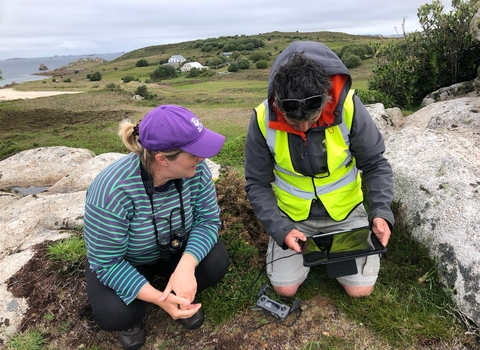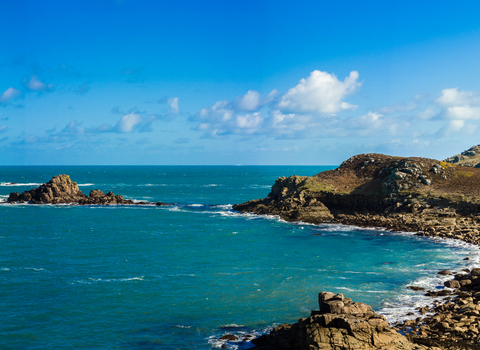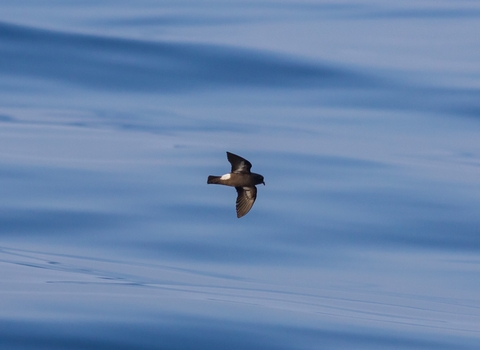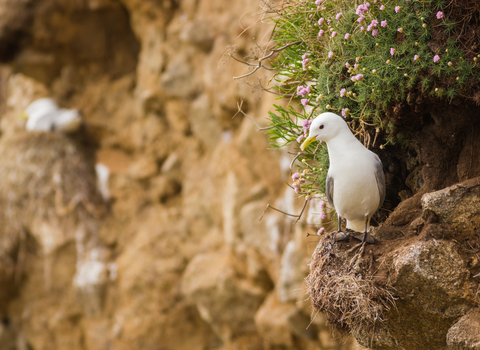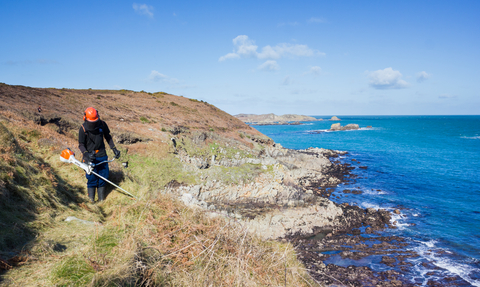
On land and at sea
Our work for wildlife
The islands are home to a wonderful variety of wildlife habitats and maintaining these is a delicate balancing act. Supported by the Isles of Scilly AONB, our conservation activities benefit native island wildlife and ensure that people can explore the archipelago. There are three key areas where we benefit habitats - heathland, wetlands and marine - but our work stretches far beyond these.
Heathland management
The heathland habitats and historic landscapes on the Isles of Scilly are of international importance. They include huge areas of all the inhabited and some of the uninhabited islands, including Peninnis and Porth Hellick Down on St Mary's, Wingletang Down on St Agnes, most of Gugh, around the Daymark on St Martin's and Shipman Head Down on Bryher, amongst many others. Without management they would become degraded and obscured by the encroachment of vigorous species such as gorse, bramble and bracken, which would also prevent access to these areas. We use recognised land management techniques, including machinery, conservation grazing and working with local contractors, to help create a diverse range of habitats.
Our skilled rangers use brush cutters, chainsaws, ‘walk-behind’ tractors with cutters and flail attachment, an Alpine tractor and flail with a collector are the machines. Occasionally we employ local contractors to assist with cutting larger areas of bracken and gorse and with jobs such as digging of ponds or re-profiling of ditches, or partner with local land managers who can carry out work efficiently. Many of our wildlife sites are grazed by our herd of Ruby Red Devon cattle. They create open and varied habitats which are good for wildflowers, insects and birds.
Care is taken to ensure that permissive paths remain open in grazed areas. If an electric fence crosses a recognised path we will install a temporary gate for you to use. Where practically possible we use pushchair friendly gates and contain livestock in a way that offers alternative routes for walkers and horse riders. In most cases, there are alternative routes to take to avoid walking through the livestock. Dog walkers are welcome but please keep dogs under close control where grazing is occurring. Most of our heathland management is seasonal. We do not cut or clear scrub during the bird breeding season and the use of grazing animals is targeted so that it is most effective.
Wetland management
Wetlands offer incredibly rich and diverse habitats for our invertebrates, plants, birds and mammals. They provide food, shelter and breeding grounds for some of our resident wildlife all year round and also for migrating wildlife at various points throughout the year. They are also vital in terms of providing the majority of our drinking water across St Mary's (supplemented during the summer months by the de-salination plant) as well as flood defences to some key areas of habitation and industry.
The Isles of Scilly has a handful of wetland sites, including Higher Moors and Lower Moors on St Mary's, and pools on St Agnes, Bryher and Tresco. Many of these are designated SSSI areas. These sites have changed dramatically over the centuries, but now we are working as part of our management plan to restore these wetland sites for wildlife. The winters usually see our Ranger Team working on our wetland sites on Lower and Higher Moors managing the reed and willow, as this is the best time of year to carry out the work.
When Scilly's Cottages were thatched and livestock farming was more viable our wetland sites were managed as a matter of course and as a part of every day life. Reeds were traditionally used for thatching and livestock bedding as well as in agriculture as a fuel for burning, grazing cattle or creating screens to shelter plants. In recent times these practices have become less common or died out all together and as a result the management of our wetland sites, which happened as a bi-product of human's finding a use for nature, ceased.
Between the 1970's and the late 1990's very little was done in terms of management of the wetland sites on St Mary's and they began to dry out, becoming overrun by willow and bramble. In 1999, the Isles of Scilly Wildlife Trust began to manage and clear these overgrown areas to restore the integrity of the sites, and in 2015, we implemented a long-term programme to manage larger areas of reed on a 4-year rotational basis, and also a programme of willow coppicing and removal. By cutting the reed and willow during the winter months on a rotational basis, plant diversity is encouraged without allowing "succession" to take place and a wider variety of native species are allowed to thrive.
Working for our sealife
Much of our work at sea involves monitoring and surveying seabirds, seals and other marine life, and helping them to thrive where possible. We encourage a low-use approach to plastic, support and organise beach cleans around the islands to remove marine litter and help businesses to minimise their impacts on marine wildlife.
Scilly is regionally, nationally and internationally important for breeding seabirds both in terms of number of birds and diversity of species. We have over 8,000 pairs of 13 species of breeding seabird, nesting across over 50 sites. We are home to internationally important numbers of lesser black-backed gull and storm petrel, nationally important numbers of great black-backed gull and shag, regionally important numbers of puffin, razorbill, Manx shearwater, fulmar and common tern, and are one of only two sites in England where Manx shearwater and storm petrel are known to breed (the other being Lundy).
However, the survival of our seabirds is threatened by the pollution, over-exploitation and degradation of our marine and coastal habitats. The information that we gather on our seabirds not only contributes to long-term data sets, but also informs our habitat management plans and wider marine protection work in future.
Regular all-island counts of seabirds have been completed since 1970. In some cases, they reveal some startling trends, including a reduction in the overall number of breeding seabird pairs between 1983 and 2016 of 31%. Annual counts of Annet's breeding numbers have fallen by 29% since 2000. Common terns have also suffered, with total breeding failure in several of the last few surveys. Kittiwakes are also threatened, showing an 89% drop in numbers and loss of 5 sub-colonies since 2006. They failed to breed entirely in 2021. Herring gull, lesser black-backed gull and shag breeding populations have all declined by over 20% since 2006.
On Scilly, the biggest threat to those seabirds that nest in burrows such as Manx shearwaters and storm petrel is predation by rats. The Seabird Recovery Project (2013-2017) removed this threat from St Agnes and Gugh, and this has resulted in an impressive increase in birds and successful breeding. We have seen the first successful breeding of Manx shearwaters on those islands in living memory, as well as the first confirmed breeding by storm petrels in 2015. Manx shearwater numbers have trebled from 171 pairs in 2006 to 523 pairs in 2015. Since 2006 there has been a marked increase in the numbers of both razorbill and guillemots across the islands, whilst puffins have remained relatively stable.
We are now managing the legacy of this partnership project to ensure that the island of St Agnes & Gugh remain rat-free. Find out more about new proposals for the Seabird Recovery Project.
Some of our staff are trained in seal survey protocols, recording, photographing as well as hands on data processing. Seal photo ID is one of the most powerful yet non invasive scientific research methods, as it reveals information on movements, site fidelity, fecundity, mortality as well as life expectancy. We assist visiting surveyors where possible and champion a low-impact approach to watching wildlife. We also protect and monitor key seal haul out sites, to ensure that disturbance is kept to a minimum. We have worked with boat operators to deliver WiSe (Wildlife Safe) training to encourage marine users to operate at a safe distance from seabirds and other marine life.
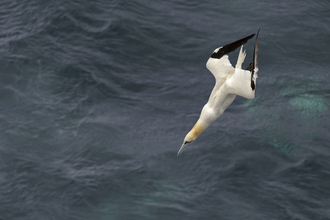
Winter Gannets
Our Seabird Officer - Hester Odgers talks about the awesome wildness of wintering Gannets in Scilly.
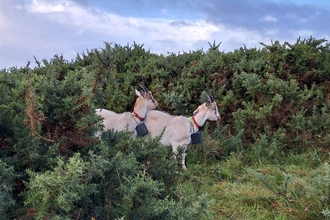
Scilly Billy Naming Ceremony
An amazing day had by all at the Scilly Billy naming ceremony. Welcome to the herd Fergus and Gorse!
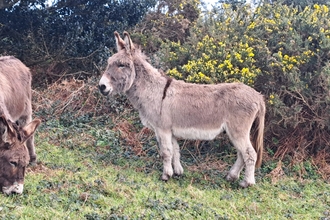
Donkeys at Helvear
Donkeys Sandy and Bobby (who arrived in October 2023) have taken up the mantle of professional gorse-munchers and have moved to Helvear…


